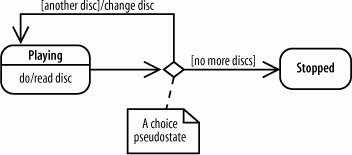Section 14.7. Advanced Pseudostates
14.7. Advanced PseudostatesYou've already seen initial pseudostates, which mark the start of a state diagram. There are additional pseudostates that are useful for directing the flow of traffic between states. A choice pseudostate is used to emphasize that a Boolean condition determines which transition is followed. A choice has guards on each of its outgoing transitions, and the transition that is followed depends on the guard. In Figure 14-19, the CD player will go back to the Playing state if another disc is available or will go to the Stopped state if there are no more discs. Notice that this is an alternate, and cleaner, way to model the transition choice in Figure 14-11. Figure 14-19. The path followed after a choice depends on the guard
Fork and join pseudostates show branching into concurrent states and then rejoining. For example, in Figure 14-20, the fork breaks the incoming transition into two transitions, allowing Searching and Pacing to happen simultaneously. The join then merges its two incoming transitions into one outgoing transition. Figure 14-20 is an alternate way to model Figure 14-18. In Figure 14-18, forking and joining are implied by showing the initial pseudostates and final states. Figure 14-20. Forks and joins show concurrent states |
EAN: 2147483647
Pages: 175
